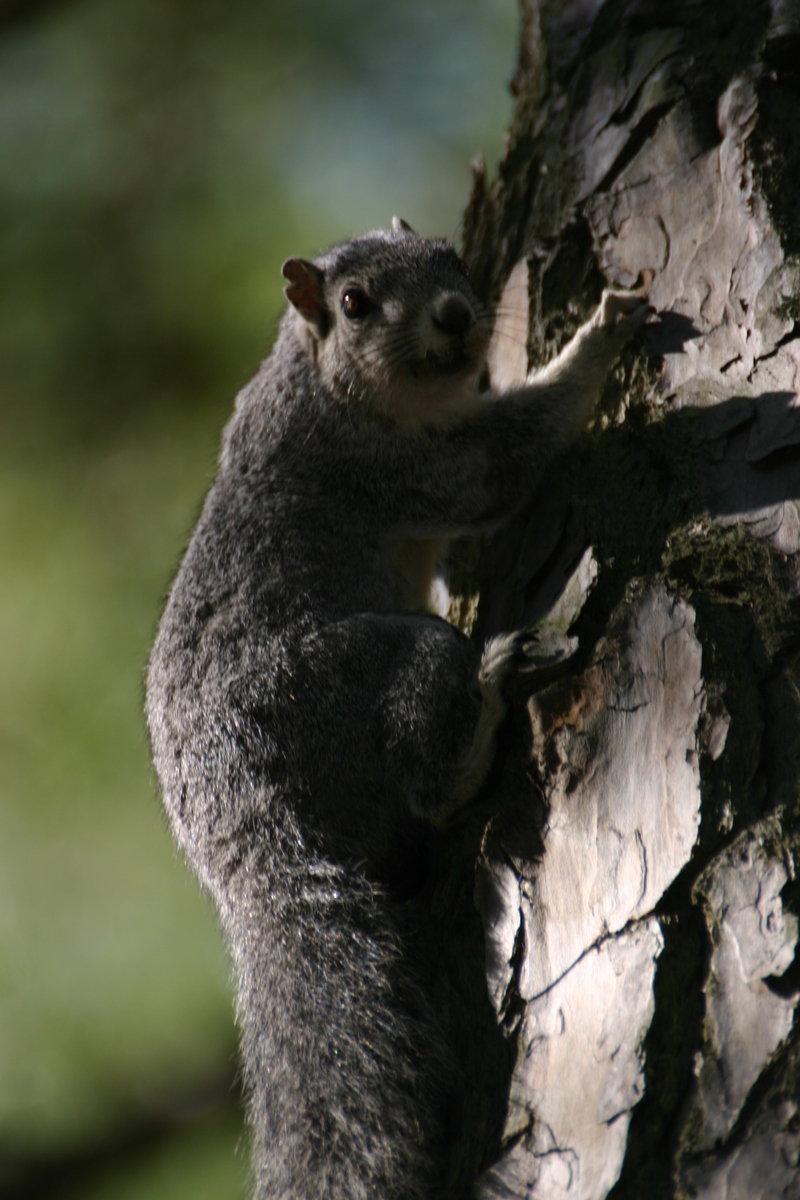Delmarva Fox Squirrel (Sciurus niger cinereus) [Photo] Delmarva fox squirrel, Chincoteague, Brian Gratwicke. Source: http://en.wikipedia.org/wiki/Image:Sciurus_niger.jpg
Delmarva Fox Squirrel, Sciurus niger cinereus
CATEGORY - Mammals PHYLUM AND SUBPHYLUM - CHORDATA,
CLASS AND SUBCLASS - MAMMALIA,
ORDER AND SUBORDER - RODENTIA,
FAMILY AND SUBFAMILY - SCIURIDAE,
GENUS AND SUBGENUS - SCIURUS,
SPECIES AND SSP - NIGER, CINEREUS
SCIENTIFIC NAME - SCIURUS NIGER CINEREUS
Common Names - Fox Squirrel, Delmarva Squirrel, Stump-eared Squirrel, Cat Squirrel.
WHAT IT IS
Distinguishing characteristics: Teeth 1/1, 0/0, 1/1, 3/3 = 20; coloration uniform light grizzled-gray above with steel blue cast; belly and feet white; tail with pronounced black stripe on outer edges. Melanistic form occurs in which belly and feet are blackish. Can be distinguished from gray squirrel mainly by larger size and reduced dentition. Mean measurements of 36 adults from Dorchester county, MD: Averaqe body length 22.8 inches; average tail 10.75 inches, maybe as long as 15 inches. Average weight is 2.5-3 lbs. The hind foot 3 inches.
WHERE IT LIVES
The Delmarva fox squirrel is associated predominantly with small stands of mature timber with an open understory, largely in agricultural areas The Delmarva fox squirrel does occur in areas with dense undergrowth, but under those conditions is forced to compete with the gray squirrel. Hedgerows or fencerows are often used as travel lanes between woodlots (06). The Delmarva fox squirrel is also associated with savanna or parklike areas; lowland, swampy areas and narrow tree zones along rivers and streams. The association with water is indirect, however, through the effect of water on vegetation (i.e., less understory, and difficulty in harvesting timber in wet areas). Inhabited forested areas are most often a mixture of mature hardwoods and conifers; tree groups mentioned in literature include oak, hickory, gum, beech, walnut, and loblolly pine. Delmarva fox squirrels do sometimes occur in pure loblolly pine stands, and some authors have indicated old-growth loblolly pine forests are the preferred habitat of the Delmarva fox squirrel. Others point out that the original range of the Delmarva fox squirrel extended beyond the range of the loblolly pine. In a study on MD's Eastern Shore, The current range of the Delmarva fox squirrel includes forest regions such as the oak-pine forest, loblolly-shortleaf pine forest, and oak-gum-cypress forest. Historically, the Delmarva fox squirrel
GOOD PLACES TO SEE IT
The historic range of this squirrel was southeastern Pennsylvania and southern New Jersey and in the Delaware, Maryland and Virginia portions of the Delmarva Peninsula. Today, it is mainly limited to several counties in Maryland and the Chincoteaque National Wildlife Refuge in Virginia. Delmarvas were absent from Pennsylvania for the better part of this century or longer. Between April 1987 and October 1988, 20 Delmarvas were translocated from Maryland to a site in Chester County. Eastern Neck National Wildlife Refuge; Chincoteague National Wildlife Refuge; Blackwater National Wildlife Refuge (two separate tracts); Maryland's Wye Island Natural Resource Manage-ment Area and LeCompte Wildlife Management Area; and a private site.
ECOLOGY
Unique features associated with the Delmarva fox squirrel include tree cavities and dead snags which may provide denning sites. The Delmarva fox squirrel dens mostly in the winter but builds leaf nests more commonly in the summer. As mentioned above, the Delmarva fox squirrel uses hedgerows or treed fencerows as travel lanes between woodlots.
ACTIVITY
During the spring, they feed on tree buds and flowers and will also eat fungi, insects, fruit and seeds. Delmarvas prefer to make their dens in the hollows of trees but will also make nests of leaves and twigs in the crotch of trees, in a tangle of vines on a trunk or at the end of large branches. Mating occurs in late winter and early spring. Gestation is about 44 days with most young born in February, March and April. Litters average one to six young, with the female raising them by herself.
SOCIAL/MATING SYSTEM
The Delmarva fox squirrel will usually raise her young in tree dens, but when these are unavailable, will construct leaf nests similar to those of gray squirrels. Tree dens are more commonly used in winter and leaf nests in the summer (04). The Delmarva fox squirrel has been known to use nesting boxes attached to tree trunks approximately 6-7 meters above ground. One author states that the Delmarva fox squirrel builds nests near the tips of branches in old pines, from 9 to 15 meters above ground. However, Delmarva fox squirrels are known to build leaf nests in deciduous trees also, and nests may occur in crotches in the trunk. Nests are constructed of leaves and twigs from the tree in which they are located. REPRODUCTIVE CHARACTERISTICS: Delmarva fox squirrel females raise the young alone. Breeding season is extended, with peaks in February and March, and in July and August. The crop of young is usually larger in the late winter (30). Females may reach maturity at 8 or 9 months, and may breed at 10 to 11 months. Older females may breed twice a year, while yearlings breed only once. From 1 to 6 young are born after a gestation of about 45 days. Average litter size is 3 or 4 young. Food availability seems to govern the size and number of litters. PARENTAL CARE: The Delmarva fox squirrel is polygamous and the female raises the young alone. Young are born naked and blind. Eyes open at 5 weeks and weaning takes place at 9 to 12 weeks. The Delmarva fox squirrel is not sensitive to human disturbance, and young can be handled in the nest with minimal adverse effect. The female will not abandon her young, but may move the young to a different nest if disturbed. Family bonds are dissolved at weaning
FORAGING/PREDATORY BEHAVIOR
Predators include red and gray foxes, weasels, minks, eagles and raptors. Nestlings and young may be taken by raccoons, opossums and rat snakes
Text Source: http://www.nature-wildlife.com/dmsqtxt.htm
